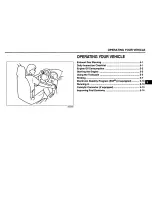
Topping up the washer fluid
G
WARNING
Windscreen washer concentrate is highly
flammable. If it comes into contact with hot
components in the front compartment, it
may ignite. There is a risk of fire and
injury.
Make sure that windscreen washer con-
centrate is not spilled next to the filler
neck.
X
Open the service cover.
X
Pull cap
:
upwards at the tab.
X
If available, pull the removable nozzle up
as far as the stop.
X
Top up with washer fluid.
X
If available, push the removable nozzle
down and push it inside.
X
Replace and tightly screw on cap
:
.
X
Close the service cover.
i
See "Technical data" for information on
windscreen washer fluid and antifreeze.
Checking wheels and tyres
G
Warning
A flat tyre severely impairs the driving,
steering and braking characteristics of the
vehicle. There is a risk of an accident.
Do not drive with a flat tyre. Immediately
replace the flat tyre with your spare wheel,
or consult a qualified specialist workshop.
G
WARNING
Damaged tyres can cause tyre inflation
pressure loss. As a result, you could lose
control of your vehicle. There is a risk of
accident.
Check the tyres regularly for signs of dam-
age and replace any damaged tyres imme-
diately.
G
WARNING
Insufficient tyre tread will reduce tyre
traction. The tyre is no longer able to dis-
sipate water. This means that on wet road
surfaces, the risk of aquaplaning increa-
ses, in particular where speed is not adap-
ted to suit the driving conditions. There is
a risk of accident.
If the tyre pressure is too high or too low,
tyres may exhibit different levels of wear
at different locations on the tyre tread.
Thus, you should regularly check the tread
depth and the condition of the tread across
the entire width of all tyres.
Minimum tyre tread depth for:
R
summer tyres: 3 mm
R
M+S tyres: 4 mm
For safety reasons, replace the tyres before
the legally prescribed limit for the mini-
mum tyre tread depth is reached.
!
If you cannot avoid driving over obsta-
cles, e.g. kerbs, do so slowly and at an
obtuse angle only. You could otherwise
damage the wheel rims and tyres.
Modification work on the brake system and
wheels is not permitted. The use of spacers or
brake dust shields is not permitted. This
invalidates the general operating permit for
the vehicle.
Check the wheels and tyres for damage at
least once a month, as well as after driving
off-road or on poorly surfaced roads.
Run-in new tyres at moderate speeds for the
first 100 km. The tyres only attain their max-
imum performance after this distance.
Vibrations, audible noises and unusual han-
dling characteristics, e.g. pulling to one side,
can indicate damage to wheels or tyres.
Checking wheels and tyres
157
>> Maintenance and care
.
Z
















































